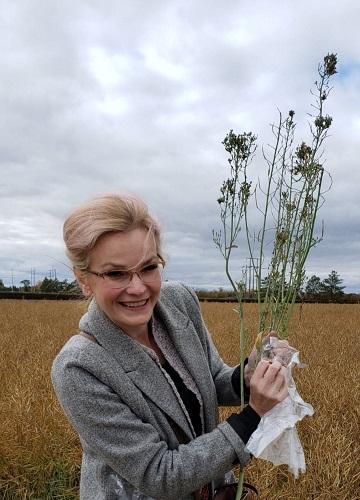
Credit: Karolina Pusz-Bochenska, Edel Perez-Lopez, Tim J. Dumonceaux, Chrystel Olivier, and Tyler J. Wist
St. Paul, MN (February 2020)–Transmitted by insects, especially the aster leafhopper, aster yellows (AY) outbreaks can cause severe production losses in many crops, including carrots, lettuce, and canola. Canola is a billion-dollar crop for Canada but the growing season in Western Canada is very short. Depending on the environmental conditions and number of infected leafhoppers, AY can be transmitted to canola in less than 24 hours and the leafhoppers can continue spreading the disease for the rest of their lives.
Scientists based in Saskatoon, Canada, developed a rapid, simple laboratory and field-adaptable DNA extraction method that allowed them to identify both plant pathogen and insect vector using molecular barcoding and gene sequencing. This method reduced the time from collection of insects to a positive identification of the presence of a pathogen from up to two weeks to less than one hour. They published their findings in Plant Health Progress.
“Using this methodology, we were able to go from DNA extraction to pathogen detection in less than one hour,” according to lead author Karolina Pusz-Bochenska. “This rapid technique allows for same-day management decisions essential to preventing the spread of insect-transmitted pathogens.”
To achieve this quick turnaround, Pusz-Bochenska and colleagues used DNA lysis paper to extract pathogen DNA, which was a novel choice that they combined with the rapid-detection potential of the sensitive and field-adaptable loop-mediated isothermal amplification (LAMP) assay. According to Pusz-Bochenska, this combination was groundbreaking.
“When the aster leafhoppers migrate into Canada in spring, they bring AY phytoplasmas that can cause devastating damage to canola crops, and we need a rapid-test to determine if these migrant leafhoppers are a threat or not. A rapid analysis of the leafhoppers allows us to estimate the infectivity of the population and forecast the risk to the crops, allowing the growers to make management decisions if the leafhoppers have arrived in their fields.”
While this research focuses on agriculture, this techniques has potential applications to horticulture as well as animal and human health. For more details, read “A Rapid, Simple, Laboratory and Field-Adaptable DNA Extraction and Diagnostic Method Suitable for Insect-Transmitted Plant Pathogen and Insect Identification,” which is freely available through the end of March.
###
Media Contact
Ashley Bergman Carlin
[email protected]
651-994-3832
Related Journal Article
http://dx.




